Abstract
Assessing carbon emission reduction potential is vital for achieving carbon peak and neutrality in the maritime sector. In this study, we proposed a universal framework for assessing the effectiveness of different measures on carbon emission reduction from ships, including port and ship electrification (PSE), ship speed optimization (SSO), and clean fuel substitution (CFS). Firstly, the projection method of future ship traffic flows and activity levels relies on a neural network, and the ARIMA model was proposed. Then, the potential of various emission reduction measures was detailed and analyzed under different intensity scenarios. The proposed model was applied to Wuhan port, the results indicate that CFS is the most effective for long-term decarbonization, potentially achieving a carbon peak by 2025 under an aggressive scenario. For the short to medium term, PSE is favored due to technical maturity. SSO primarily delays emissions growth, making it a suitable auxiliary measure. These findings guide emission reduction strategies for ports, fostering green and sustainable shipping development.
1. Introduction
Shipping serves as the primary mode of transportation for global trade, facilitating the movement of 80–90% of internationally traded goods and contributing significantly to the rapid development of the global economy [1]. However, it is essential to recognize that shipping also generates a substantial amount of greenhouse gas (GHG) emissions, which play an important role in driving global warming and climate change [2]. According to the International Maritime Organization (IMO), in 2018, global GHG emissions from shipping reached 10.76 billion metric tons, with 1.056 billion metric tons of CO2 emissions [3]. The IMO has further emphasized that, in the absence of effective carbon reduction initiatives within the shipping sector, GHG emissions from shipping will continue to rise significantly in the future [4]. As the urgency of addressing global climate change intensifies, there is a growing focus on implementing measures to reduce carbon emissions within the shipping industry.
In alignment with the global response to combat climate change, the IMO adopted an initial strategy in April 2018 aimed at curbing GHG emissions from ships [5]. This strategy sets ambitious targets compared to 2008 levels, with the primary objectives of reducing the carbon emission intensity of international shipping by at least 40% by 2030 and decreasing total annual GHG emissions by at least 50% by 2050 [5,6]. Governments and organizations worldwide have introduced various policies in succession to mitigate carbon emissions from shipping. Notably, in 2020, China, as the world’s largest developing country, explicitly announced its commitment to achieving a carbon peaking by 2030 and carbon neutrality by 2060 [7]. In this context, it is crucial to assess the potential of carbon reduction measures in shipping and develop green port solutions.
In recent years, significant efforts have been dedicated to exploring viable measures for reducing emissions in the shipping industry [4,8,9,10]. These measures can be broadly categorized into three types: source reduction, indirect reduction, and energy transformation.
Source reduction refers to reducing emissions by changing or reducing the source of carbon emissions. The measures encompass several strategies such as utilizing high-efficiency main engines and optimizing ship types [11], adopting electric propulsion [12], and retrofitting carbon capture equipment [13]. Optimizing ship design can reduce emissions while saving costs. The research on electric ships has made significant progress in recent years and has gradually become a solution for the development of sustainable transportation [14,15]. Furthermore, efforts are underway to develop and implement carbon capture and storage (CCS) technologies for ships, although progress in this area has been relatively slow [16].
Indirect reduction refers to reducing carbon emissions by improving certain processes or systems. The measures include the utilization of shore power at terminals [17] and operational tactics such as ship speed optimization [18], routing optimization [19,20,21], and ship scheduling [20,21]. As a means to reduce emissions when ships are berthed at ports, shore power has been a focal point of research with a focus on the construction of shore power systems and the assessment of their benefits [22]. The speed of a vessel significantly impacts fuel consumption and carbon emissions [23]. Many studies utilize mathematical models and intelligent algorithms to optimize the speed of vessels, aiming to achieve fuel savings and emissions reduction under varying transportation conditions [18,24]. Optimizing route planning can reduce both distance and time, consequently lowering fuel consumption and carbon emissions [25].
The energy transformation focuses on converting traditional fuels to low- or zero-carbon energy sources. There are high expectations for the use of clean fuels (such as LNG, methanol, ammonia, and biofuels) to replace fossil fuels on ships, in addition to a wide variety of technical and operational abatement measures [4,26]. Moreover, these reviews delve into essential physicochemical characteristics of different fuels, the sources and methods of manufacturing, considerations related to their transport and storage, and their practical applications as carbon-neutral and zero-carbon energy sources [27,28,29,30], which have provided valuable insights into the viability and sustainability of these alternative fuels in the context of maritime transport.
Although a large number of previous studies have accumulated on carbon emission reduction in shipping, the following two aspects have been less explored: (1) the comprehensive comparison of the emission reduction potential of difference measures, and (2) the carbon peaking path of ships in ports within the constraints of the IMO’s initial strategy targets and the dual carbon strategic goals set by the Chinese government. It necessitates an examination of which emission reduction measures should take precedence and a quantification of the resulting reduction in carbon emissions. To fill this gap, this study established a multi-scenario emission reduction assessment model for ports. The emission reduction potentials of the three emission reduction measures, namely port and ship electrification (PSE), ship speed optimization (SSO), and clean fuel substitution (CFS) were comprehensively compared under different intensity scenarios. The feasibility of achieving the carbon peaking target by 2030 at the port was assessed for various emission reduction measures, and emissions reductions brought about by different measures were quantified. Then, the carbon emission reduction paths and policy recommendations for inland ports were discussed.
2. Methods
2.1. Model Construction
A complete research framework for reducing carbon emissions from port ships should include influencing factors analysis, carbon emission prediction, carbon emission reduction scenario simulation, and emission reduction effect analysis [31]. This section constructs a model for assessing and predicting carbon emission reductions from port ships based on scenario analysis. The model includes three modules (see Figure 1), i.e., the ship activity level prediction module, the carbon emission control scenario module, and the carbon emission reduction analysis module. The ship activity prediction module is used to forecast future port ship traffic flow and elements related to ship activity levels, such as ship speed, activity duration, and ship activity range. These predictive data serve as the foundational information for carbon emission calculations and emission reduction analyses. The emission control scenario module is employed to create various intensity levels of emission reduction scenarios, including lenient, enhanced, and aggressive scenarios. These scenarios encompass multiple emission reduction strategies, such as shore-based power and ship electrification, alternative clean fuels, and ship speed optimization. The emission reduction analysis module quantitatively analyzes these scenarios to assess the potential of each emission reduction strategy based on the calculation of carbon emissions. This analysis helps identify the best strategy for reducing emissions and provides prioritized recommendations for the port to meet its carbon-peaking goals. The details of each module are described in the following subsections.
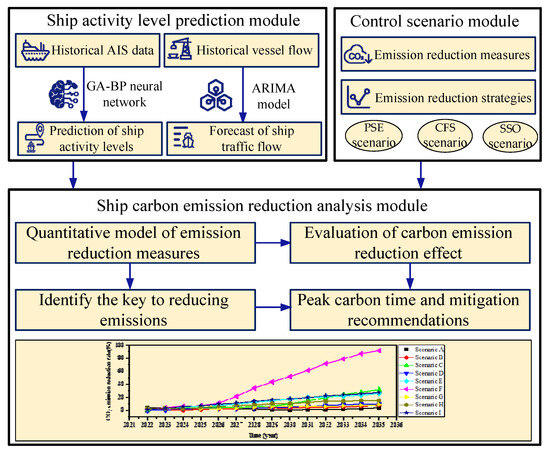
Figure 1.
Framework of ship carbon emission reduction assessment model.
2.2. Ship Activity Level Prediction
2.2.1. Ship Traffic Flow Forecasts
The future ship traffic flow is a key parameter for predicting carbon emissions. Here, the Autoregressive Integrated Moving Average (ARIMA) model, a category of time series models renowned for their exceptional forecasting accuracy, was adopted to forecast future ship traffic flow using historical data. The ARIMA (p, d, q) model can be expressed as [32]
where p is the number of autoregressive terms, d is the number of no seasonal differences needed for stationarity, q is the number of lagged forecast errors in the prediction equation; is the predicted value at time t, represents the magnitude of the autocorrelation, denotes the autocorrelation of errors, and is the error.
The model processes non-smooth data with a discernible trend by applying differential transformations, where the number of differences corresponds to the “d” value in the ARIMA (p, d, q) model. Subsequently, it computes the Autocorrelation Coefficient (ACF) and Partial Autocorrelation Coefficient (PACF) values from the smoothed data series to preliminarily determine the “p” and “q” values of the ARIMA (p, d, q) model. The detailed calculation process is thoroughly outlined in reference [33].
2.2.2. Ship Activity Level Forecasts
The ship activity level in the future is another key parameter in predicting carbon emissions. Liu and Duru [34] proposed a Bayesian prediction algorithm to infer future ship movements and corresponding ship emissions based on the probability of historical ship movements, navigation configuration, and ship details, which gives us good enlightenment. In this study, we employ a Genetic Algorithm optimized Back Propagation (GA-BP) neural network model, which is trained using historical AIS data, to predict emissions-related factors of ships. These factors include average ship speed, berthing time, sailing time, and anchoring time. Additionally, we use the model to estimate future ship types and the direction of ship traffic within ports.
Compared to traditional Bayesian models, BP neural networks require fewer assumptions for prediction. Moreover, due to their powerful learning capability and adaptive nature, BP neural networks can model complex non-linear systems, which is superior to linear regression models [35]. In the modeling process, GA was used to address the limitations of the BP neural network in terms of adopting optimal thresholds and weights.
The ship activity level prediction model utilizes the classical 3-layer BP neural network architecture. The error backpropagation algorithm is employed to train and establish connections among each neural layer. The input layer consists of 5 neurons, representing ship type, average sailing speed, sailing time, anchoring time, and berthing time. The output layer includes 4 neurons, which predict average ship speed, sailing time, anchoring time, and berthing time. The number of nodes in the hidden layer was determined as 5 through a trial-and-error approach. The values of other model parameters can be found in Table 1.

Table 1.
Parameters of GA-BP prediction model.
2.3. Control Scenario Setting
Emission reduction scenario development serves as an effective method for investigating carbon peaking. Within this module, we create multiple emission reduction scenarios to assess the potential for reducing emissions through various measures. The following assumptions are considered when formulating the carbon emission reduction scenarios.
- We only consider carbon emissions from ships in the port. Carbon emissions from port machinery, transportation vehicles, and other sources are not included in the analysis.
- Assuming the implementation of emission reduction measures is a gradual process, quantifying these measures and evenly distributing them across each year.
- The maturity of the technology and the cost of implementation are not considered when developing the strategy in this study.
- During the research period, there were no unexpected events that would have a significant impact on the normal development of shipping and ports.
Based on commonly employed carbon reduction measures in the shipping industry [10], coupled with the evolving characteristics of future inland vessel types and the trend in alternative energy sources development [11], we established three different emission reduction strategies (i.e., PSE, SSO, and CFS) from the perspectives of source reduction, indirect reduction, and energy substitution. The PSE mainly includes emission reduction measures such as the use of shore power and the electrification of ships in ports, while SSO mainly considers the optimization of the speed of ships during transportation. CFS is mainly concerned with the substitution of cleaner fuels, such as liquefied natural gas and other zero-carbon fuels.
For each emission reduction strategy, three scenarios, i.e., lenient, enhanced, and aggressive, are constructed based on different strengths. For example, in terms of the PSE strategies, Scenario A assumes that 50% of ships at berth use shore power, Scenario B assumes that 50% of ships at berth use shore power, and 50% of ships in port are replaced with electric propulsion, and Scenario C assumes that all ships at berth use shore power and 80% of ships in port are replaced with electric propulsion. Therefore, we established 9 different emission reduction scenarios, which are listed in Table 2. The percentages in the table represent the proportion of ships adopting each emission reduction measure. Moreover, establish a baseline scenario (BAU) in which no emission reduction measures are implemented, and compare it with other scenarios.

Table 2.
Different carbon emission reduction scenarios setting.
2.4. Ship Carbon Reduction Accounting
Due to the uncertainty of future ship fuels, the fuel-based method is not suitable for predicting future ship carbon emissions. The activity-based approach, on the other hand, is more suitable for assessing specific emission reduction policies because it can reflect the impact of changes in various factors, such as vessel traffic, activity mode, and activity time on emission reduction [36]. Based on the activity-based approach, the carbon emissions from ships during sailing and berthing are estimated by
where is the CO2 emission over a complete trip of ships (ton); is operating time of the power equipment (h); refers to the power equipment of ship (kW); is engine load factor (%), equivalent to the cube of the actual speed and the design speed of ship; is the carbon emission factor (g/kWh), which can be referred Huang et al. [37]. The subscript indicates different sailing conditions such as cruising, berthing and maneuvering, and the indicates the main and auxiliary engines.
In addition, within this section, we have constructed relevant quantitative models to evaluate the emission reductions resulting from the measures implemented in various emission reduction scenarios.
- (1)
- Carbon emission reduction from the PSE strategies. The use of shore power will reduce carbon emissions from auxiliary engines when the ship is at berth. In addition, when a ship is replaced with electric propulsion, it can be considered that no carbon emissions are generated. Therefore, the carbon reduction achieved in the PSE strategies iswhere is the number of ships connected to shore power, is the number of electric ships.
- (2)
- Carbon emission reduction from the CFS strategies. Clean fuels include low-carbon fuels (e.g., LNG) and zero-carbon fuels (methanol, hydrogen, ammonia, etc.). Zero-carbon fuels are known to produce no carbon emissions. Therefore, the carbon emission reduction of CFS strategies iswhere is the carbon emission factor of marine fuel; is the carbon emission factor of LNG, which is 457 g/kWh [38]; is the number of LNG-fuelled ships, and is the number of zero-carbon fuels-fuelled ships.
- (3)
- Carbon emission reduction from the SSO strategies. Reducing ship speed can reduce carbon emissions from ships. Since the load factor, , is directly affected by the ship’s speed, in which is the sailing speed and is the design speed of ships. Therefore, the emission reduction of SSO strategies iswhere is the optimized ship speed; is the number of ships with speed optimization measure.
3. Case Study
3.1. Study Area and Data
Wuhan port is the largest inland port in Central China situated in the middle reaches of the Yangtze River (113°41′–115°05′ E and 29°58′–31°22′ N). It is an important port in the national strategy for the development of China’s Yangtze River Economic Belt. The port contains a total of 15 port areas, i.e., 14 cargo port areas and 1 passenger port area, together with 139 harbor tugs and barges and 43 production berths. The Wuhan port’s layout is depicted in Figure 2. In this study, the historical ship traffic flow data were obtained from the Yangtze River Maritime Bureau. Moreover, the AIS data of Wuhan port from 2014 to 2022 were collected.
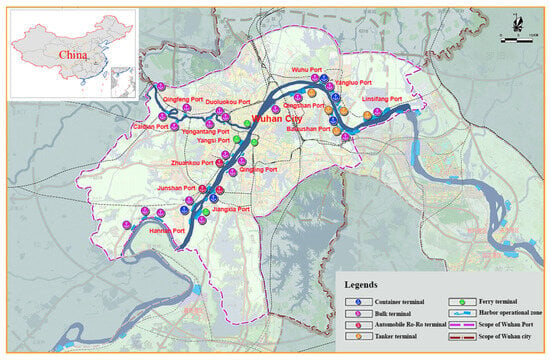
Figure 2.
The Wuhan port layout [39].
3.2. Model Evaluation
The prediction accuracy of future ship traffic flow and its activity level directly affects the model results. Therefore, this section verifies the established ARIMA and GA-BP algorithms, respectively.
The ARIMA algorithm was compiled by the Python language and the historical traffic flow data were used as input to obtain the future traffic flow, as illustrated in Figure 3. It is worth noting that Wuhan implemented lockdown measures from 23 January to 8 April 2020, due to COVID-19, and the data for this specific period was excluded from the prediction process. Comparing the predicted traffic flow with the actual traffic flow in 2022, it can be found that the predicted value of the monthly ship flow is consistent with the actual value with a small deviation. Consequently, the ARIMA model developed in this study demonstrates its utility for ship traffic flow prediction.
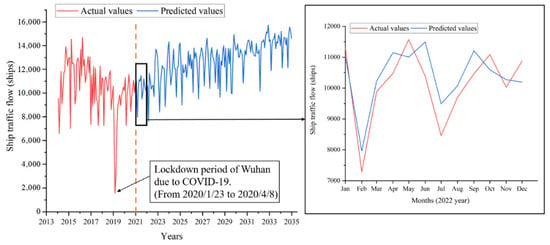
Figure 3.
Comparison of predicted and actual ship traffic flow values.
To validate the effectiveness of the GA-BP neural network, the AIS data of Wuhan port from January to November 2021 are used as training samples, with the AIS data from December serving as validation samples. The ship type attributes of each ship sample, as well as the sailing time, average speed, anchoring time, and berthing time in the port area are obtained and input into the GA-BP neural network constructed in Section 2.2.2. Figure 4 shows the comparison between the actual and predicted values of 70 randomly selected sample ship activity level elements. The mean square error (MSE), the mean absolute error (MAE), and the mean relative error (MRE) are used to evaluate the validity of the prediction, which is listed in Table 3. The three metrics confirm the robust performance of the prediction model. In the analysis of the results, we compared the summed outcomes of 70 samples for ship sailing and anchoring times. It found that the model is better at predicting the ship’s anchoring time, the relative error is 3.12%, and the relative error in predicting the ship’s sailing time and berthing time is 8.14% and 10.46%, respectively. In general, the proposed GA-BP model has certain reliability.
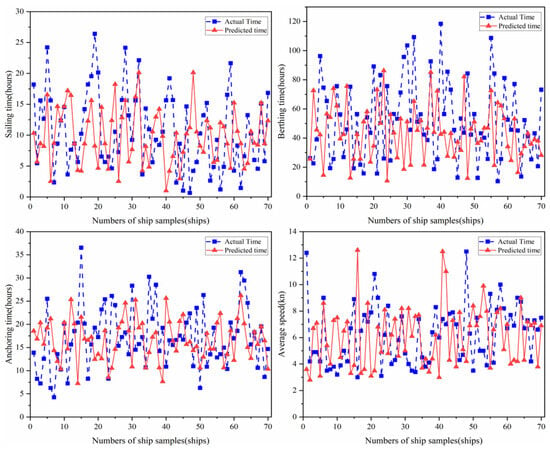
Figure 4.
Comparison of the predicted and actual values of the activity level elements of the sample ships.

Table 3.
Evaluation of the GA-BP model prediction results.
3.3. Analysis of Future Ship Activity Levels
From the ship flow perspective, it is generally understood that a higher influx of incoming ships poses a greater challenge for carbon emission reduction within the port area. The anticipated distribution of “ship-to-port” flow in the future is illustrated in Figure 5 and Figure 6. It is evident that cargo ships and oil tankers primarily constitute the types of vessels arriving at the port, while passenger ships and tugboats are the predominant types of vessels active within the port. In terms of specific port areas, Qingshan, Linsifang, Yangluo, and Baihushan stand out with the highest numbers of arriving ships. Among these, Linsifang and Yangluo port areas are dedicated to cargo terminals, whereas Qingshan and Baihushan port areas mainly accommodate oil tankers and cargo terminals. This indicates that the locations within Wuhan Port experiencing the highest vessel traffic should be the focal points for implementing vessel emission reduction measures. Furthermore, another key finding is that cargo ships will remain the primary source of emissions in the future. Hence, it is crucial to select emission reduction strategies that align with the specific types of ship activities.
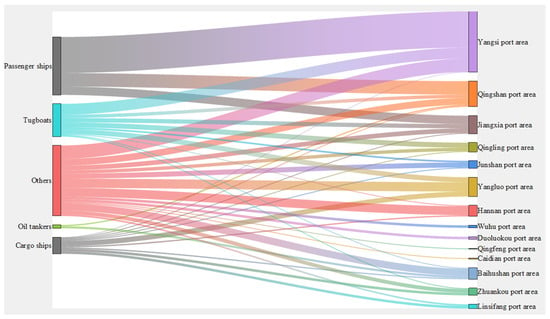
Figure 5.
Distribution of arriving ship activity flow among different port areas.
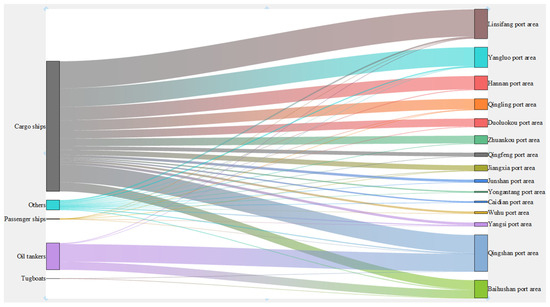
Figure 6.
Distribution of harbor ship activity flow among different port areas.
3.4. Analysis of Carbon Emission Reduction in Different Port Areas
Shore power supply and electric ships are effective measures for mitigating ship fuel consumption and emissions, particularly during vessel operations within harbors [40]. To compare the emission reduction potential of shore power utilization in various port areas of Wuhan Port, this section exclusively examines several emission reduction scenarios of PSE strategies.
Figure 7 illustrates the reduction of carbon emissions at different port areas in 2030 under the PSE strategies. It can be seen that the carbon emissions from ships in Yangluo, Qingshan, Linsifang, and Baihushan port areas are relatively large. The implementation of shore power and electric ship measures can effectively curtail carbon emissions from port vessels to a certain extent. However, we found an interesting thing that even with the most stringent emission reduction scenario (Scenario C), the carbon emission reduction rate of other ports except the Yangsi port area is only 30 to 40%. This discrepancy arises because the majority of emissions come from passing ships in inland rivers, while PSE measures only reduce the emissions of arrived ships and harbor ships. Consequently, the substantial carbon emissions generated by passing ships remain largely unaffected.
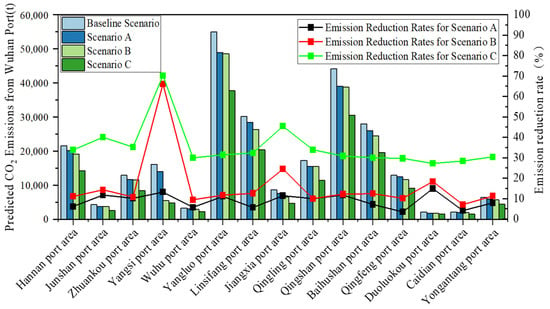
Figure 7.
Carbon emission reduction of different port areas in 2030 under PSE scenario.
In addition, we have observed that the effectiveness of PSE measures is also closely intertwined with the functions of the port area and the predominant ship types. There is a big difference between the freight terminal and passenger terminal for the carbon emission reduction from ships. For example, the Yangsi port area is a ferry/passenger ship terminal, and ferries/passenger ships are the main vessels anchored and active in the port. When electric ships are replaced, carbon emission is significantly reduced (up to 70%) in the Yangsi port. In contrast, it only reduces by 30 to 40% in the freight terminals.
3.5. Analysis of Carbon Emission Reduction under Different Scenarios
To assess the emission reduction effectiveness and potential across different scenarios, Figure 8 illustrates the estimated ship carbon emissions from 2024 to 2035 for each emission reduction scenario. In general, although ship carbon emissions are expected to decrease in all scenarios compared to the baseline emission scenario, the extent of reduction varies depending on the measures and their intensity. The results indicate that the emission reduction effects of the PSE and CFS strategies are more pronounced, especially when adopting aggressive scenarios. Specifically, the adoption of PSE and CFS emission reduction measures has the potential to help Wuhan port achieve its peak carbon emissions target for vessels, aiming to reach the peak before 2030. As shown in Figure 8a, in Scenario C, it is projected that carbon emissions from vessels will peak in 2029, at approximately 212,156 tons. However, by 2035, there will still be around 18,000 tons of carbon emissions produced from ships, indicating the limitations of PSE in reducing emissions in inland ports. One possible reason is that the transit ships do not use shore power in PSE scenarios, and this part of carbon emissions has not been solved. From the perspective of emission reduction potential, the CFS measures have the most significant impact on reducing carbon emissions from ships. Figure 8b reveals that under Scenario F, ship carbon emissions in Wuhan port are expected to peak in 2026, at around 190,667 tons. By 2035, carbon emissions are projected to reduce to 25,000 tons, representing a reduction of an order of magnitude from the current levels. This suggests that clean energy substitution measures have significant emission reduction potential, suitable for medium to long-term emission reductions. In contrast, shore power and ship electrification are better suited as transitional measures for short to medium-term emissions reduction. According to the prediction results in Figure 8c, the carbon emission reduction effect of port ships using the SSO strategy is not ideal. Figure 8c shows that speed optimization measures can only slow down the growth rate of carbon emissions from port ships, and carbon emissions cannot peak even under the most stringent scenario. Duan et al. [19] found that reducing ship speed can reduce carbon emissions by about 20% per ship, but for the port as a whole, the increasing freight demand and vessel traffic on inland rivers will offset this part of the emission reduction. Therefore, speed optimization can only be used as an auxiliary emission reduction measure. To achieve the port carbon peak target, it must be combined with other emission reduction measures.
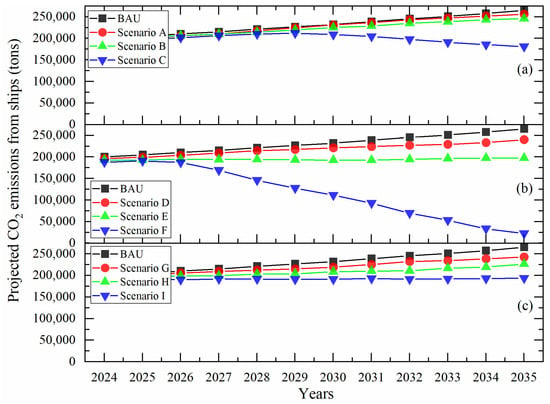
Figure 8.
Trends in CO2 emissions from ships under different future emission reduction scenarios. (a) PSE scenarios (b) CFS scenarios (c) SSO scenarios.
To further evaluate the reduction effect under different reduction scenarios, the reduction rate α = (E_base − E)⁄(E_base) × 100% was used as the evaluation index, where E_base is the CO2 emissions from ships under the base scenario; E is the CO2 emissions from ships under the reduction scenario. With the potential for emission reductions in the order of Scenario F > Scenario C > Scenario I > Scenario E > Scenario H > Scenario D > Scenario G > Scenario B > Scenario A. As shown in Figure 9, Scenario F has the highest carbon emission reduction potential. The carbon reduction rate in 2030 is expected to reach 50%, exceeding the 40% reduction target set by the IMO. The second is scenario C, which is projected to reduce carbon emissions by about 25% in 2030. It shows that clean energy development and electricity promotion are crucial if the port wants to reach the carbon emission reduction target ahead of schedule.
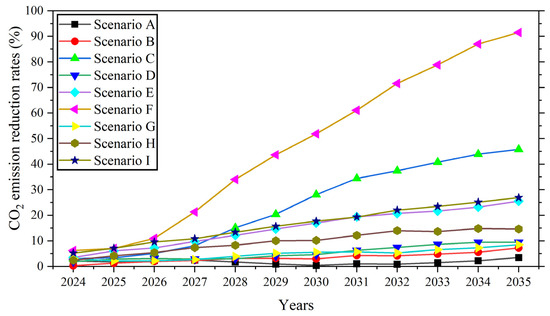
Figure 9.
Emission reduction rates for each abatement strategy under different scenarios.
4. Conclusions
In this study, we proposed a framework for a carbon emission reduction assessment model for port ships, which can provide new insights to stakeholders. Using the proposed method, the short-, medium-, and long-term emission reduction strategies for Wuhan port were discussed, and the priority measures under the carbon peaking target were explored. The results show that clean fuel substitution (CFS) measures have the most significant impact on reducing carbon emissions from ships in Wuhan port. Moreover, the port and ship electrification (PSE) measure will also bring obvious benefits to ship carbon emission reduction. However, energy efficiency measures such as ship speed optimization (SSO) can only mitigate the growth of ship carbon emissions, so they can be used as auxiliary emission reduction strategies. In addition, under the premise of the immature application of clean energy technologies, the PSE can be used as the major emission reduction measure in the short and medium term. If conditions allow, combining a variety of emission reduction measures is conducive to faster and better achieving the goal of carbon peak and carbon neutrality in ports.
Two shortcomings in this study could be improved in future work. Firstly, the model has certain limitations due to the existence of assumptions, future research should strengthen field investigation to fill the uncertainty caused by the assumptions. Secondly, this study only assessed part of the technical emission reduction measures. The effectiveness of other technical measures (e.g., carbon capture and storage), as well as policy measures (e.g., carbon tax) in reducing carbon emissions from ships, should be further considered.
Author Contributions
C.Z.: methodology, funding acquisition, investigation conceptualization; W.T.: methodology, writing—original draft; Z.L.: methodology, data curation; H.H.: data curation, methodology, writing—review and editing; L.H.: investigation conceptualization; C.X.: investigation, methodology; L.W.: methodology, writing—review and editing, supervision. All authors have read and agreed to the published version of the manuscript.
Funding
This work was supported by the National Science Foundation of China (Grant No. 52171349), the Key Research Plan of Zhejiang Provincial Department of Science and Technology, China (Grant No. 2021C01010).
Institutional Review Board Statement
Not applicable.
Informed Consent Statement
Not applicable.
Data Availability Statement
The original contributions presented in the study are included in the article, further inquiries can be directed to the corresponding author.
Acknowledgments
We sincerely thank the editor and reviewers for their kind and helpful comments on this manuscript.
Conflicts of Interest
The authors declare no conflicts of interest.
References
- Cristea, A.; Hummels, D.; Puzzello, L.; Avetisyan, M. Trade and the greenhouse gas emissions from international freight transport. J. Environ. Econ. Manag. 2013, 65, 153–173. [Google Scholar] [CrossRef]
- Farkas, A.; Degiuli, N.; Martić, I.; Vujanović, M. Greenhouse gas emissions reduction potential by using antifouling coatings in a maritime transport industry. J. Clean. Prod. 2021, 295, 126428. [Google Scholar] [CrossRef]
- Bosch, D.W., Jr. Rocking the Boat: The Legal Implications of IMO 2020 for Future IMO Greenhouse Gas Reduction Strategies and the Impacts to Louisiana. LSU J. Energy Law Resour. 2020, 8, 11. [Google Scholar]
- Xing, H.; Stuart, C.; Spence, S.; Chen, H. Alternative fuel options for low carbon maritime transportation: Pathways to 2050. J. Clean. Prod. 2021, 297, 126651. [Google Scholar] [CrossRef]
- Joung, T.H.; Kang, S.G.; Lee, J.K.; Ahn, J. The IMO initial strategy for reducing Greenhouse Gas (GHG) emissions, and its follow-up actions towards 2050. J. Int. Marit. Saf. Environ. Aff. Shipp. 2020, 4, 1–7. [Google Scholar] [CrossRef]
- Xing, H.; Spence, S.; Chen, H. A comprehensive review on countermeasures for CO2 emissions from ships. Renew. Sustain. Energy Rev. 2020, 134, 110222. [Google Scholar] [CrossRef]
- Runa, A.; Zhang, Z.; Zhang, H. Carbon emission peak and carbon neutrality under the new target and vision. In Proceedings of the 2021 International Conference on Advanced Electrical Equipment and Reliable Operation (AEERO), Beijing, China, 15–17 October 2021; IEEE: New York, NY, USA, 2021. [Google Scholar]
- Yan, X.; He, Y.; Fan, A. Carbon footprint prediction considering the evolution of alternative fuels and cargo: A case study of Yangtze river ships. Renew. Sustain. Energy Rev. 2023, 173, 113068. [Google Scholar] [CrossRef]
- Schwartz, H.; Gustafsson, M.; Spohr, J. Emission abatement in shipping–is it possible to reduce carbon dioxide emissions profitably? J. Clean. Prod. 2020, 254, 120069. [Google Scholar] [CrossRef]
- Balcombe, P.; Brierley, J.; Lewis, C.; Skatvedt, L.; Speirs, J.; Hawkes, A.; Staffell, I. How to decarbonise international shipping: Options for fuels, technologies and policies. Energy Convers. Manag. 2019, 182, 72–88. [Google Scholar] [CrossRef]
- Stec, M.; Tatarczuk, A.; Iluk, T.; Szul, M. Reducing the energy efficiency design index for ships through a post-combustion carbon capture process. Int. J. Greenh. Gas Control 2021, 108, 103333. [Google Scholar] [CrossRef]
- Kim, Y.R.; Kim, J.M.; Jung, J.J.; Kim, S.Y.; Choi, J.H.; Lee, H.G. Comprehensive design of dc shipboard power systems for pure electric propulsion ship based on battery energy storage system. Energies 2021, 14, 5264. [Google Scholar] [CrossRef]
- Güler, E.; Ergin, S. An investigation on the solvent based carbon capture and storage system by process modeling and comparisons with another carbon control methods for different ships. Int. J. Greenh. Gas Control 2021, 110, 103438. [Google Scholar] [CrossRef]
- Sulligoi, G.; Vicenzutti, A.; Menis, R. All-electric ship design: From electrical propulsion to integrated electrical and electronic power systems. IEEE Trans. Transp. Electrif. 2016, 2, 507–521. [Google Scholar] [CrossRef]
- Geertsma, R.D.; Negenborn, R.R.; Visser, K.; Hopman, J.J. Design and control of hybrid power and propulsion systems for smart ships: A review of developments. Appl. Energy 2017, 194, 30–54. [Google Scholar] [CrossRef]
- Leung, D.Y.; Caramanna, G.; Maroto-Valer, M.M. An overview of current status of carbon dioxide capture and storage technologies. Renew. Sustain. Energy Rev. 2014, 39, 426–443. [Google Scholar] [CrossRef]
- Tan, Z.; Liu, Q.; Song, J.; Wang, H.; Meng, Q. Ship choice and shore-power service assessment for inland river container shipping networks. Transp. Res. Part D Transp. Environ. 2021, 94, 102805. [Google Scholar] [CrossRef]
- Ma, W.; Zhang, J.; Han, Y.; Zheng, H.; Ma, D.; Chen, M. A chaos-coupled multi-objective scheduling decision method for liner shipping based on the NSGA-III algorithm. Comput. Ind. Eng. 2022, 174, 108732. [Google Scholar] [CrossRef]
- Duan, G.; Fan, T.; Chen, L.; Ma, J. Floating marine debris mitigation by vessel routing modeling and optimization considering carbon emission and travel time. Transp. Res. Part C Emerg. Technol. 2021, 133, 103449. [Google Scholar] [CrossRef]
- Yu, Y.; Tu, J.; Shi, K.; Liu, M.; Chen, J. Flexible optimization of international shipping routes considering carbon emission cost. Math. Probl. Eng. 2021, 2021, 6678473. [Google Scholar] [CrossRef]
- Dulebenets, M.A. Green vessel scheduling in liner shipping: Modeling carbon dioxide emission costs in sea and at ports of call. Int. J. Transp. Sci. Technol. 2018, 7, 26–44. [Google Scholar] [CrossRef]
- Sciberras, E.A.; Zahawi, B.; Atkinson, D.J. Electrical characteristics of cold ironing energy supply for berthed ships. Transp. Res. Part D Transp. Environ. 2015, 39, 31–43. [Google Scholar] [CrossRef]
- Taskar, B.; Andersen, P. Benefit of speed reduction for ships in different weather conditions. Transp. Res. Part D Transp. Environ. 2020, 85, 102337. [Google Scholar] [CrossRef]
- Han, Y.; Ma, W.; Ma, D. Green maritime: An improved quantum genetic algorithm-based ship speed optimization method considering various emission reduction regulations and strategies. J. Clean. Prod. 2023, 385, 135814. [Google Scholar] [CrossRef]
- Ma, W.; Han, Y.; Tang, H.; Ma, D.; Zheng, H.; Zhang, Y. Ship route planning based on intelligent mapping swarm optimization. Comput. Ind. Eng. 2023, 176, 108920. [Google Scholar] [CrossRef]
- Lindstad, H.; Eskeland, G.S.; Psaraftis, H.; Sandaas, I.; Strømman, A.H. Maritime shipping and emissions: A three-layered, damage-based approach. Ocean Eng. 2015, 110, 94–101. [Google Scholar] [CrossRef]
- Hansson, J.; Månsson, S.; Brynolf, S.; Grahn, M. Alternative marine fuels: Prospects based on multi-criteria decision analysis involving Swedish stakeholders. Biomass Bioenergy 2019, 126, 159–173. [Google Scholar] [CrossRef]
- Noor, C.M.; Noor, M.; Mamat, R. Biodiesel as alternative fuel for marine diesel engine applications: A review. Renew. Sustain. Energy Rev. 2018, 94, 127–142. [Google Scholar] [CrossRef]
- Bilgili, L. Comparative assessment of alternative marine fuels in life cycle perspective. Renew. Sustain. Energy Rev. 2021, 144, 110985. [Google Scholar] [CrossRef]
- Wang, J.; Zhao, C. Reducing carbon footprint in a resilient supply chain: Examining the critical influencing factors of process integration. Int. J. Prod. Res. 2023, 61, 6197–6214. [Google Scholar] [CrossRef]
- Kong, Y.; Liu, J.; Chen, J. Exploring the carbon abatement measures in maritime supply chain: A scenario-based system dynamics approach. Int. J. Prod. Res. 2023, 61, 6131–6152. [Google Scholar] [CrossRef]
- Katambire, V.N.; Musabe, R.; Uwitonze, A.; Mukanyiligira, D. Forecasting the Traffic Flow by Using ARIMA and LSTM Models: Case of Muhima Junction. Forecasting 2023, 5, 616–628. [Google Scholar] [CrossRef]
- Abebe, M.; Noh, Y.; Kang, Y.J.; Seo, C.; Kim, D.; Seo, J. Ship trajectory planning for collision avoidance using hybrid ARIMA-LSTM models. Ocean. Eng. 2022, 256, 111527. [Google Scholar] [CrossRef]
- Liu, J.; Duru, O. Bayesian probabilistic forecasting for ship emissions. Atmos. Environ. 2020, 231, 117540. [Google Scholar] [CrossRef]
- Wu, S.; Zhao, G.; Wu, B. Real-time prediction of the mechanical behavior of suction caisson during installation process using GA-BP neural network. Eng. Appl. Artif. Intell. 2022, 116, 105475. [Google Scholar] [CrossRef]
- Zhou, C.; Ding, Y.; Huang, H.; Huang, L.; Lu, Z.; Wen, Y. Meso-level carbon dioxide emission model based on voyage for inland ships in the Yangtze River. Sci. Total Environ. 2022, 838, 156271. [Google Scholar] [CrossRef] [PubMed]
- Huang, H.; Zhou, C.; Huang, L.; Xiao, C.; Wen, Y.; Li, J.; Lu, Z. Inland ship emission inventory and its impact on air quality over the middle Yangtze River, China. Sci. Total Environ. 2022, 843, 156770. [Google Scholar] [CrossRef]
- Xu, H.; Yang, D. LNG-fuelled container ship sailing on the Arctic Sea: Economic and emission assessment. Transp. Res. Part D Transp. Environ. 2020, 87, 102556. [Google Scholar] [CrossRef]
- Zhou, C.; Huang, H.; Liu, Z.; Ding, Y.; Xiao, J.; Shu, Y. Identification and analysis of ship carbon emission hotspots based on data field theory: A case study in Wuhan Port. Ocean. Coast. Manag. 2023, 235, 106479. [Google Scholar] [CrossRef]
- Sciberras, E.A.; Zahawi, B.; Atkinson, D.J. Reducing shipboard emissions–Assessment of the role of electrical technologies. Transp. Res. Part D Transp. Environ. 2017, 51, 227–239. [Google Scholar] [CrossRef]
Disclaimer/Publisher’s Note: The statements, opinions and data contained in all publications are solely those of the individual author(s) and contributor(s) and not of MDPI and/or the editor(s). MDPI and/or the editor(s) disclaim responsibility for any injury to people or property resulting from any ideas, methods, instructions or products referred to in the content. |
© 2024 by the authors. Licensee MDPI, Basel, Switzerland. This article is an open access article distributed under the terms and conditions of the Creative Commons Attribution (CC BY) license (https://creativecommons.org/licenses/by/4.0/).